UPSC Exam > UPSC Notes > NCERT Video Summary: Class 6 to Class 12 (English) > NCERT Summary: The Early Societies (Theme 1: From The Beginning Of Time)
NCERT Summary: The Early Societies (Theme 1: From The Beginning Of Time) | NCERT Video Summary: Class 6 to Class 12 (English) - UPSC PDF Download
| Table of contents |

|
| Introduction |

|
| The Story of Human Evolution |

|
| Early Humans: Ways of Obtaining Food |

|
| Mind map |

|
Introduction
- It was 5.6 million years ago (written as mya) that the first human-like creatures appeared on the earth's surface. Human beings resembling us (henceforth referred to as 'modern humans') originated about 160,000 years ago.
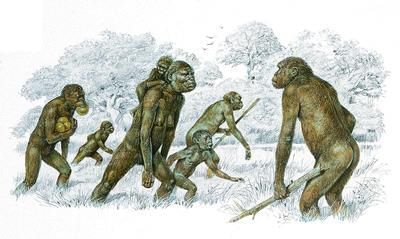 Human-like creatures
Human-like creatures - During this long period of human history, people learned to arrange food, to make stone tools, and to communicate with each other. Although other ways of obtaining food were adopted later, hunting-gathering continued.
- Discoveries of human fossils, stone tools, and cave paintings help us to understand early human history.
- The evidence for human evolution comes from fossils of species of humans that have become extinct. Fossils can be dated either through direct chemical analysis or indirectly by dating the sediments in which they are buried. Once fossils are dated, a sequence of human evolution can be worked out.
- About 200 years ago, many scholars were often reluctant to accept that fossils and other finds were actually connected with early forms of humans due to their belief in the Old Testament of the Bible, according to which human origin was regarded as an act of Creation by God.
- In 1859, when Charles Darwin’s On the Origin of Species was published, marked a landmark in the study of evolution. Darwin argued that humans had evolved from animals a long time ago
The Story of Human Evolution
➢ The Precursors of Modern Human Beings
- The story of human evolution is enormously long and somewhat complicated. It is possible to trace these developments back to between 36 and 24 mya.
- 36 million years ago, primates, a category of mammals, emerged in Asia and Africa. Subsequently, by about 24 mya, there emerged a subgroup amongst primates, called hominoids. This included apes. And, much later, about 5.6 mya, we find evidence of the first hominids.
- While hominids have evolved from hominoids and share certain common features, there are major differences as well:
(i) Hominoids have a smaller brain than hominids.
(ii) Hominoids are quadrupeds, walking on all fours, but with flexible forelimbs. Hominids, by contrast, have an upright posture and bipedal locomotion (walking on two feet).
(iii) There are also marked differences in the hand, which enables the making and use of tools. - Two lines of evidence suggest an African origin for hominids.
(i) It is the group of African apes that are most closely related to hominids.
(ii) The earliest hominid fossils, which belong to the genus Australopithecus, have been found in East Africa and date back to about 5.6 mya. - Hominids:
(i) They belong to a family known as Hominidae, which includes all forms of human beings.
(ii) They have a large brain size, upright posture, bipedal locomotion, and specialization of the hand.
(iii) Hominids are further subdivided into branches, known as a genus, of which Australopithecus and Homo are important. Each of these in turn includes several species. - The major differences between Australopithecus and Homo relate to brain size, jaws, and teeth.
The former has a smaller brain size, heavier jaws, and larger teeth than the latter.
- The name Australopithecus comes from a Latin word, ‘austral’, meaning ‘southern’, and a Greek word, ‘pinkos’, meaning ‘ape.’ Characteristics:
(i) They retained many features of an ape, such as a relatively small brain size in comparison to Homo, large back teeth, and limited dexterity of the hands.
(ii) Upright walking was also restricted, as they still spent a lot of time on trees.
(iii) They retained characteristics (such as long forelimbs, curved hand and foot bones, and mobile ankle joints) suited to life on trees.
(iv) Over time, as tool making and long-distance walking increased, many human characteristics also developed. - The remains of early humans are often distinguished from one another on the basis of differences in bone structure. These characteristics may have evolved due to what has been called a positive feedback mechanism.

- There is indirect evidence of bipedalism as early as 3.6 mya. This comes from the fossilized hominid footprints at Laetoli, Tanzania. Fossil limb bones recovered from Hadar, Ethiopia provides more direct evidence of bipedalism.
- Around 2.5 mya, with the onset of a phase of glaciation (or an Ice Age), when large parts of the earth were covered with snow, there were major changes in climate and vegetation. Due to the reduction in temperatures as well as rainfall, grassland areas expanded at the expense of forests, leading to the gradual extinction of the early forms of Australopithecus (that were adapted to forests) and the replacement by species that were better adapted to the drier conditions. Among these were the earliest representatives of the genus Homo.
- Homo is a Latin word, meaning ‘man’, although there were women as well! Scientists distinguish amongst several types of Homo. So fossils are classified as Homo habilis (the toolmaker), Homo erectus (the upright man), and Homo sapiens (the wise or thinking man).
- As the finds in Asia belong to a later date than those in Africa, it is likely that hominids migrated from East Africa to southern and northern Africa, to southern and north-eastern Asia, and perhaps to Europe, sometime between 2 and 1.5 mya.
- In some instances, the names for fossils are derived from the places where the first fossils of a particular type were found. The earliest fossils from Europe are of Homo heidelbergensis and Homo neanderthalensis. Both belong to the species of archaic (that is, old) Homo sapiens.
- In general, compared with Australopithecus, Homo have a larger brain, jaws with a reduced outward protrusion, and smaller teeth. An increase in brain size is associated with more intelligence and better memory. The changes in the jaws and teeth were probably related to differences in dietary habits.
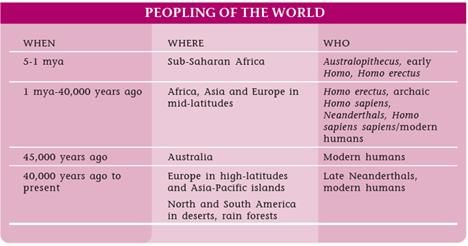
➢ Modern Human beings
- The issue of the place of origin of modern humans has been much debated. Two totally divergent views have been expounded, one advocating the regional continuity model (with multiple regions of origin), the other the replacement model (with a single origin in Africa).
- According to the regional continuity model, the archaic Homo sapiens in different regions gradually evolved at different rates into modern humans. The argument is based on the regional differences in the features of present-day humans.
- The replacement model visualizes the complete replacement everywhere of all older forms of humans with modern humans. The similarity amongst modern humans is due to their descent from a population that originated in a single region, which is Africa and the physical differences are the result of adaptation (over a span of thousands of years) by populations who migrated to the particular regions where they finally settled down.
Early Humans: Ways of Obtaining Food
- Early humans would have obtained food through a number of ways, such as gathering, hunting, scavenging, and fishing. That gathering was practiced is generally assumed rather than conclusively established, as there is very little direct evidence for it.
- While we get a fair amount of fossil bones, fossilized plant remains are relatively rare. The only other way of getting information about plant intake would be if plant remains were accidentally burnt. This process results in carbonization. In this form, organic matter is preserved for a long span of time.
- Increasingly, it is being suggested that the early hominids scavenged or foraged for meat and marrow from the carcasses of animals that had died naturally or had been killed by other predators. It is equally possible that small mammals such as rodents, birds (and their eggs), reptiles, and even insects (such as termites) were eaten by early hominids. Hunting probably began later – about 500,000 years ago.
- From about 35,000 years ago, there is evidence of planned hunting from some European sites such as Dolni Vestonice (in the Czech Republic)
- Today we find societies that live by hunting and gathering, where women and men undertake a range of different activities, but it is not always possible to suggest parallels with the past.
Question for NCERT Summary: The Early Societies (Theme 1: From The Beginning Of Time)Try yourself:What are the ways of obtaining food for early humans?
View Solution
Early Humans From Trees to Caves and Open-air Sites
- We try to reconstruct the evidence for patterns of residence by plotting the distribution of artifacts.
- It is possible that some places, where food resources were abundant, were visited repeatedly. In such areas, people would tend to leave behind traces of their activities and presence, including artifacts. The deposited artifacts would appear as patches on the landscape.
- In the Lazaret cave in southern France, a 12x4 meter shelter was built against the cave wall. At another site, Terra Amata on the coast of southern France, flimsy shelters with roofs of wood and grasses were built for short-term, seasonal visits. Pieces of baked clay and burnt bone along with stone tools, dated between 1.4 and 1 mya, have been found at Chesowanja, Kenya, and Swartkrans, South Africa.
- Hearths are indications of the controlled use of fire. This had several advantages – fire provided warmth and light inside caves, and could be used for cooking. Besides, the fire was used to harden wood, as for instance the tip of the spear. The use of heat also facilitated the flaking of tools. As important, the fire could be used to scare away dangerous animals.
Early Humans: Making Tools
- There are some features of human tool-making that are not known among apes. Certain anatomical and neurological (related to the nervous system) adaptations have led to the skilled use of hands, probably due to the important role of tools in human lives.
- The earliest evidence for the making and use of stone tools comes from sites in Ethiopia and Kenya. It is likely that the earliest stone tool makers were the Australopithecus.
- About 35,000 years ago, improvements in the techniques for killing animals are evident from the appearance of new kinds of tools such as spear-throwers and the bow and arrow. The meat thus obtained was probably processed by removing the bones, followed by drying, smoking, and storage. Thus, food could be stored for later consumption.
- There were other changes, such as the trapping of fur-bearing animals (to use the fur for clothing) and the invention of sewing needles. The earliest evidence of sewn clothing comes from about 21,000 years ago.
- Besides, with the introduction of the punch blade technique to make small chisel-like tools, it was now possible to make engravings on bone, antler, ivory, or wood.
Question for NCERT Summary: The Early Societies (Theme 1: From The Beginning Of Time)Try yourself:The earliest example of making and use of the stone tool was found in which of the following places?
View Solution
Modes of Communication: Language and Art
- There are several views on language development
(i) That hominid language involved gestures or hand movements;
(ii) That spoken language was preceded by a vocal but non-verbal communication such as singing or humming;
(iii) That human speech probably began with calls like the ones that have been observed among primates. - It has been suggested that the brain of Homo habilis had certain features that would have made it possible for them to speak. Thus, the language may have developed as early as 2 mya.
- The development of spoken language has been seen as closely connected with art since both are media for communication.
- Hundreds of paintings of animals (done between 30,000 and 12,000 years ago) have been discovered in the caves. Because of the importance of hunting, the paintings of animals were associated with ritual and magic.
- The act of painting could have been a ritual to ensure a successful hunt. These caves were possibly meeting places for small groups of people or locations for group activities. These groups could share hunting techniques and knowledge, while paintings and engravings served as the media for passing information from one generation to the next.
Hunter-Gatherer Societies: From the Present to the Past
- Can the information about living hunters and gatherers be used to understand past societies? Some archaeologists agree. On the other side are scholars who feel that present-day hunter-gatherer societies pursue several other economic activities along with hunting and gathering.
- Moreover, these societies are totally marginalized in all senses – geographically, politically, and socially. The conditions in which they live are very different from those of early humans.
- Another problem is that there is a tremendous variation amongst living hunter-gatherer societies. There are conflicting data on many issues such as the relative importance of hunting and gathering, group sizes, or the movement from place to place.
- Also, there is little consensus regarding the division of labour in food procurement. Although today generally women gather and men hunt, there are societies where both women and men hunt and gather and make tools.
Epilogue
- For several million years, humans lived by hunting wild animals and gathering wild plants. Then, between 10,000 and 4,500 years ago, people in different parts of the world learned to domesticate certain plants and animals. This led to the development of farming and pastoralism as a way of life.
- The shift from foraging to farming was a major turning point in human history. Changes that led to this shift:
(i) The last ice age came to an end about 13,000 years ago and with that warmer, wetter conditions prevailed.
(ii) As a result, conditions were favourable for the growth of grasses such as wild barley and wheat.
(iii) At the same time, as open forests and grasslands expanded, the population of certain animal species such as wild sheep, goat, cattle, pig, and donkey increased.
(iv) With some areas being clearly preferred, pressure may have built up to increase the food supply.
(v) This may have triggered the process of domestication of certain plants and animals. - It is likely that a combination of factors which included climatic change, population pressure, a greater reliance on and knowledge of a few species of plants (such as wheat, barley, rice, and millet) and animals (such as sheep, goat, cattle, donkey, and pig) played a role in this transformation.
- With the introduction of agriculture, more people began to stay in one place for even longer periods than they had done before. Thus permanent houses began to be built of mud, mud bricks, and even stone.
- Farming and pastoralism led to the introduction of many other changes such as the making of pots in which to store grain and other produce and to cook food. Besides, new kinds of stone tools came into use. Other new tools such as the plow were used in agriculture.
- Gradually, people became familiar with metals such as copper and tin. The wheel, important for both pot making and transportation, came into use. About 5,000 years ago, even larger concentrations of people began to live together in cities.
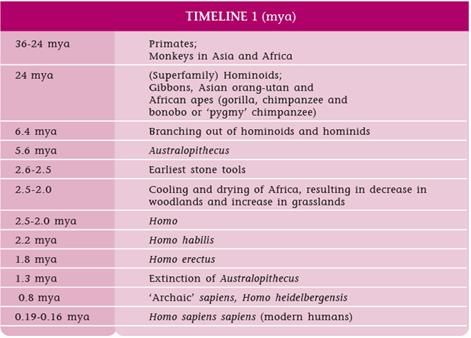
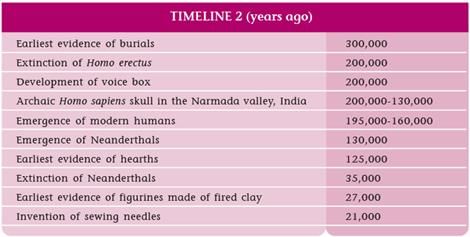
Mind map
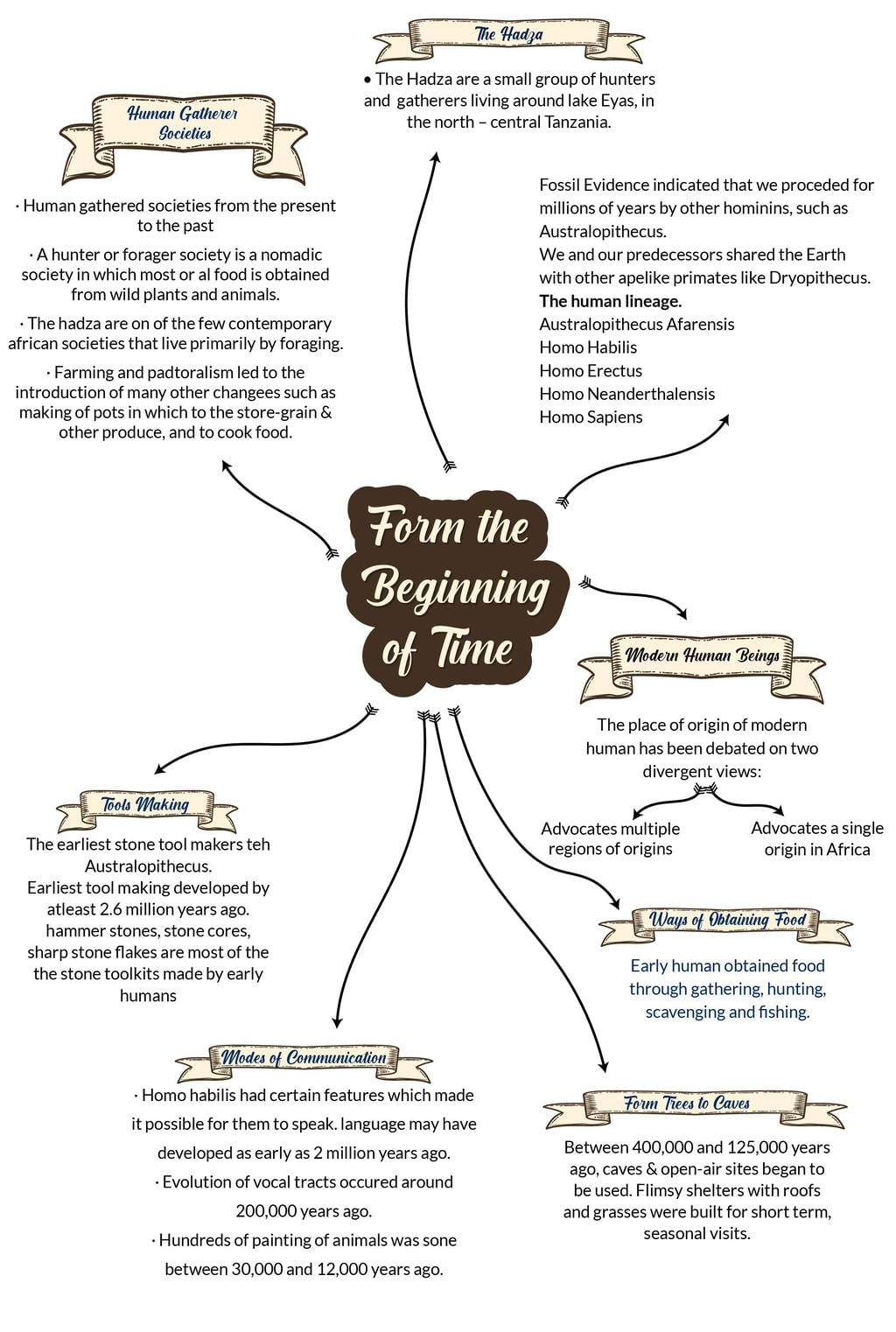
The document NCERT Summary: The Early Societies (Theme 1: From The Beginning Of Time) | NCERT Video Summary: Class 6 to Class 12 (English) - UPSC is a part of the UPSC Course NCERT Video Summary: Class 6 to Class 12 (English).
All you need of UPSC at this link: UPSC
|
494 videos|387 docs
|
FAQs on NCERT Summary: The Early Societies (Theme 1: From The Beginning Of Time) - NCERT Video Summary: Class 6 to Class 12 (English) - UPSC
| 1. What is the process of human evolution? |  |
Ans. Human evolution is the gradual development and transformation of the human species over time. It involves the biological and cultural changes that have occurred in human beings, leading to the emergence of modern humans.
| 2. How did early humans obtain food? |  |
Ans. Early humans obtained food through various means such as hunting, gathering, and scavenging. They relied on hunting animals, gathering edible plants, and scavenging leftover food from other predators.
| 3. What were the different ways early humans obtained food? |  |
Ans. Early humans obtained food through hunting, gathering, and scavenging. Hunting involved capturing and killing animals for food. Gathering involved collecting edible plants, fruits, nuts, and seeds. Scavenging involved finding and consuming leftover food from other animals.
| 4. How did the ways of obtaining food impact early human societies? |  |
Ans. The ways of obtaining food had a significant impact on early human societies. Hunting, gathering, and scavenging shaped their social structures, division of labor, and cultural practices. It also influenced the development of tools and technology used for hunting and food preparation.
| 5. What role did the ways of obtaining food play in human evolution? |  |
Ans. The ways of obtaining food played a crucial role in human evolution. They influenced the development of physical and cognitive abilities, as well as social behaviors. The transition from hunting and gathering to agriculture marked a significant milestone in human evolution, leading to the rise of settled societies and the development of civilizations.
Related Searches















